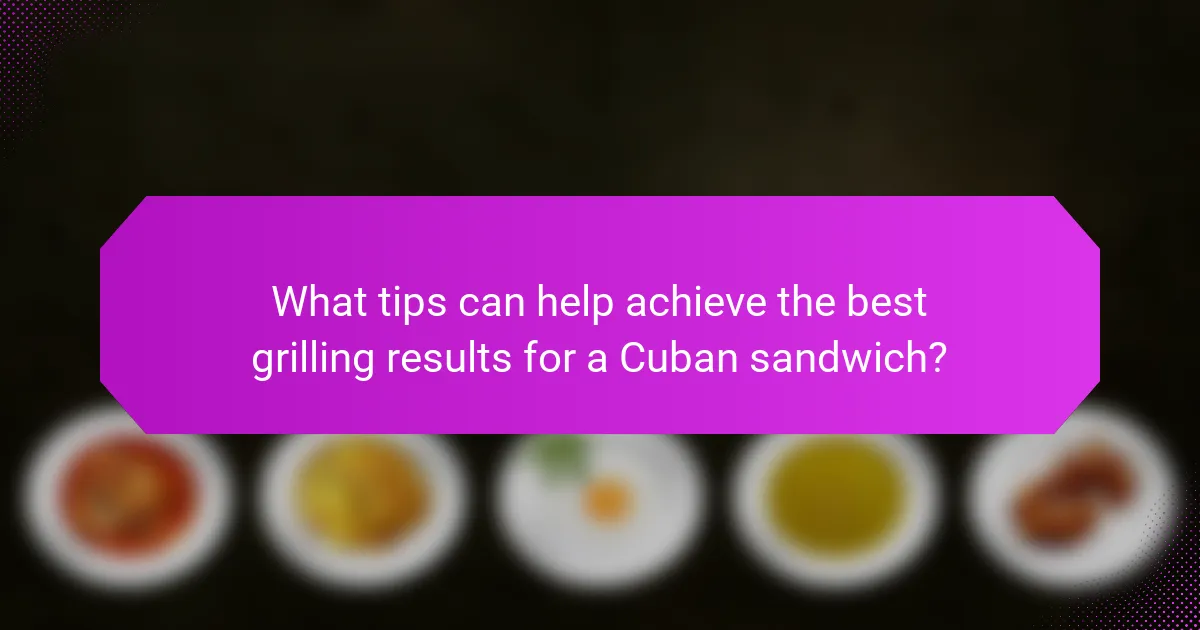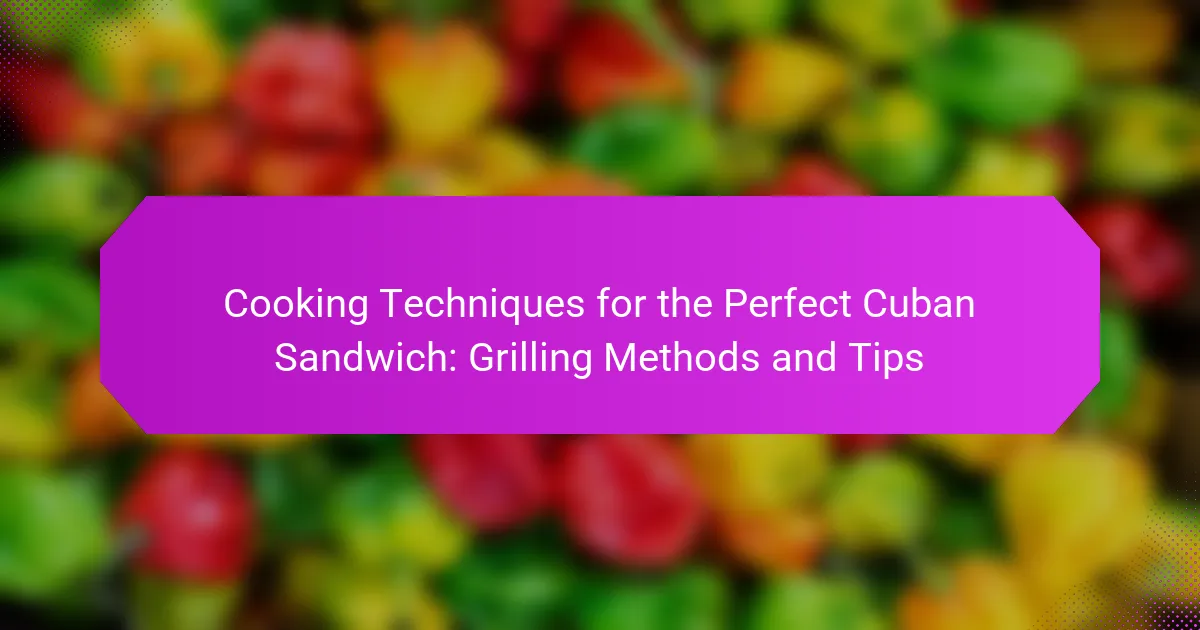The Cuban sandwich is a popular culinary dish that requires specific cooking techniques to achieve its signature flavor and texture. Key methods include grilling, layering, and pressing, each contributing to the sandwich’s crispy exterior and warm, flavorful interior. Grilling enhances the taste by caramelizing the bread, melting the cheese, and infusing smoky notes into the meat. To ensure optimal results, using a heavy pan or grill press, maintaining medium-high heat, and applying butter or oil to the bread are recommended practices. Proper cooking time and temperature are crucial for food safety and achieving the desired texture, making these techniques essential for a perfect Cuban sandwich.

What are the essential cooking techniques for a perfect Cuban sandwich?
The essential cooking techniques for a perfect Cuban sandwich include grilling, layering, and pressing. Grilling provides the necessary heat to toast the bread and melt the cheese. Layering involves placing ingredients like roast pork, ham, Swiss cheese, pickles, and mustard in a specific order. Pressing the sandwich with a heavy object or a sandwich press ensures even cooking and helps meld the flavors together. The use of a flat top grill or a panini press is recommended for optimal results. Each technique contributes to achieving the sandwich’s signature crispy exterior and warm, flavorful interior.
How does grilling impact the flavor of a Cuban sandwich?
Grilling enhances the flavor of a Cuban sandwich by adding a smoky, charred taste. The high heat from grilling caramelizes the bread’s exterior. This process creates a crispy texture that contrasts with the soft interior. Additionally, grilling melds the flavors of the sandwich’s ingredients. The heat helps to release the essential oils in the meats and cheese. As a result, the flavors become more pronounced and cohesive. Grilling also allows for the melting of cheese, which adds creaminess. Overall, grilling transforms the sandwich into a more flavorful and satisfying dish.
What grilling methods are most effective for Cuban sandwiches?
The most effective grilling methods for Cuban sandwiches are using a stovetop press or a grill pan. These methods provide even heat distribution and sufficient pressure to achieve a crispy exterior. A stovetop press, also known as a plancha, directly compresses the sandwich, ensuring the ingredients meld together. Grill pans create grill marks and allow for fat to drain away, enhancing the flavor.
Using medium heat is crucial to avoid burning the bread while ensuring the cheese melts. The ideal grilling time ranges from 3 to 5 minutes per side, depending on the heat level. This technique results in a golden-brown crust and a warm, gooey interior.
Research shows that pressing the sandwich while grilling improves texture and flavor integration. This method is widely used in Cuban cuisine to enhance the overall eating experience.
How does the choice of bread influence grilling outcomes?
The choice of bread significantly influences grilling outcomes. Different types of bread have varying moisture content, density, and structure. For example, a denser bread like Cuban bread can hold up better to high heat without becoming mushy. In contrast, lighter breads may char or burn more quickly.
Additionally, the crust thickness affects how well the bread toasts during grilling. A thicker crust can provide a satisfying crunch while protecting the interior. The flavor profile of the bread also contributes to the overall taste of the sandwich. Bread with a richer flavor, such as sourdough, can enhance the grilled ingredients.
Thus, selecting the appropriate bread can optimize texture, flavor, and structural integrity during grilling.
What ingredients are crucial for an authentic Cuban sandwich?
The crucial ingredients for an authentic Cuban sandwich include Cuban bread, roasted pork, ham, Swiss cheese, pickles, and mustard. Cuban bread is essential for its unique texture and flavor. Roasted pork, known as lechón, provides the primary protein and traditional taste. Ham adds richness and depth to the sandwich. Swiss cheese melts beautifully and complements the other flavors. Pickles offer a tangy contrast that balances the richness. Mustard is spread on the bread for added flavor and authenticity. These ingredients create the classic Cuban sandwich experience.
Which types of meats are traditionally used in Cuban sandwiches?
Cuban sandwiches traditionally use roasted pork, ham, Swiss cheese, and pickles. Roasted pork, known as lechón, is marinated and slow-cooked for flavor. Ham adds a salty contrast to the sandwich. Swiss cheese melts beautifully, enhancing the texture. Pickles provide a tangy crunch. Together, these ingredients create the classic Cuban sandwich.
What role does cheese play in the overall taste?
Cheese enhances the overall taste of a Cuban sandwich by adding creaminess and richness. It provides a savory flavor that complements the other ingredients. The melting properties of cheese create a satisfying texture. Cheese also balances the acidity from pickles and mustard. Varieties like Swiss or Gouda contribute distinct flavors. The choice of cheese can influence the sandwich’s overall profile. Studies show that cheese can elevate the sensory experience of food. Therefore, cheese is essential for a well-rounded Cuban sandwich.

How can grilling methods enhance the Cuban sandwich experience?
Grilling methods enhance the Cuban sandwich experience by adding distinct flavor and texture. The high heat from grilling caramelizes the bread, creating a crispy crust. This contrast complements the soft interior of the sandwich. Grilling also infuses smoky notes into the meat and cheese. These flavors elevate the overall taste profile. Additionally, grilling helps melt the cheese evenly, ensuring a gooey texture. The process also allows the ingredients to meld together harmoniously. Studies show that grilled sandwiches are often preferred for their enhanced sensory qualities.
What are the different grilling methods suitable for Cuban sandwiches?
The different grilling methods suitable for Cuban sandwiches include panini press, stovetop skillet, and grill. A panini press provides even heat and pressure, creating a crispy exterior. A stovetop skillet allows for manual control of heat and can be used with a heavy object to press the sandwich. Using an outdoor grill imparts a smoky flavor and can be done with a cast iron press. Each method achieves the desired texture and flavor profile typical of a Cuban sandwich.
How does the direct grilling method work for a Cuban sandwich?
Direct grilling for a Cuban sandwich involves cooking the sandwich directly over high heat. This method creates a crispy exterior while heating the contents thoroughly. The sandwich, typically made with Cuban bread, pork, ham, cheese, and pickles, is placed on a grill or griddle. The high temperature helps to melt the cheese and warm the meats quickly.
Pressing the sandwich while grilling enhances the toasting effect. This can be achieved using a heavy pan or a sandwich press. The result is a golden-brown crust that contrasts with the soft interior. Direct grilling is favored because it allows for quick cooking without drying out the ingredients.
What are the benefits of using a panini press for grilling?
A panini press offers several benefits for grilling. It provides even heat distribution, ensuring that food cooks uniformly. The design allows for both top and bottom grilling, which can reduce cooking time. The press can create attractive grill marks on sandwiches, enhancing presentation. It also provides a compact cooking option, making it suitable for small kitchens. The non-stick surfaces often found in panini presses facilitate easy cleanup. Additionally, a panini press can be used for various foods beyond sandwiches, such as vegetables and meats. These features make it a versatile tool in cooking techniques.
Why is temperature control important when grilling a Cuban sandwich?
Temperature control is important when grilling a Cuban sandwich to ensure even cooking and optimal flavor. Proper temperature allows the bread to achieve a crispy texture without burning. It also ensures that the meats and cheese are heated thoroughly, enhancing flavor and safety. Grilling at too high a temperature can lead to burnt bread and cold fillings. Conversely, too low a temperature may result in soggy bread and undercooked ingredients. Maintaining the right temperature helps achieve the ideal balance of crunch and melt. This balance is crucial for the traditional Cuban sandwich experience.
What is the ideal grilling temperature for achieving a crispy exterior?
The ideal grilling temperature for achieving a crispy exterior is between 400°F and 450°F. This temperature range allows for effective Maillard reaction, which creates a desirable crust. At 400°F, the exterior begins to brown without overcooking the interior. At 450°F, the crust forms quickly, sealing in moisture. Using this temperature range ensures a balance between crispiness and tenderness. Grilling at temperatures below 400°F may result in a soggy exterior. Conversely, temperatures above 450°F can char the food before it cooks through. Thus, maintaining a temperature between 400°F and 450°F is crucial for optimal results.
How can overcooking affect the sandwich’s texture and flavor?
Overcooking a sandwich can significantly alter its texture and flavor. The bread may become hard and dry due to excessive heat exposure. This results in a less enjoyable eating experience. Meanwhile, the fillings can lose moisture and become chewy or tough. For example, overcooked meats can turn rubbery. Additionally, flavors may become muted or overly concentrated. This can lead to an unbalanced taste profile. Maintaining proper cooking times ensures the sandwich remains tender and flavorful.

What tips can help achieve the best grilling results for a Cuban sandwich?
To achieve the best grilling results for a Cuban sandwich, use a heavy pan or a grill press. This ensures even heat distribution and proper compression of the sandwich. Preheat the grill to medium-high heat. This temperature helps to melt the cheese and toast the bread without burning it. Use butter or oil on the outside of the bread. This adds flavor and promotes a crispy texture. Grill the sandwich for about 4-5 minutes on each side. This duration allows the ingredients to heat through and the bread to achieve a golden-brown color. Use a meat thermometer to check the internal temperature. The sandwich should reach at least 165°F for safe consumption. Finally, let the sandwich rest for a minute before slicing. This helps the ingredients settle and improves the overall texture.
How can you prepare your grill for optimal cooking?
To prepare your grill for optimal cooking, start by cleaning the grates thoroughly. Use a grill brush to remove any residue from previous use. Preheat the grill to the desired temperature for at least 15 minutes. This ensures even cooking and helps prevent sticking. Adjust the heat zones for direct and indirect cooking. This allows for versatile grilling techniques. Oil the grates lightly to further reduce sticking. Check the propane levels or charcoal supply to ensure adequate fuel. Proper preparation enhances flavor and cooking efficiency.
What steps should be taken to preheat the grill effectively?
To preheat the grill effectively, first ensure the grill grates are clean. This prevents sticking and promotes even cooking. Next, turn on the grill and set it to the desired temperature. For gas grills, ignite the burners and close the lid. For charcoal grills, light the charcoal and allow it to ash over. Allow the grill to heat for 10 to 15 minutes. This duration helps achieve the right cooking temperature. Use a grill thermometer to check the temperature. A preheated grill ensures better searing and flavor.
How can you avoid common grilling mistakes when making a Cuban sandwich?
To avoid common grilling mistakes when making a Cuban sandwich, preheat the grill properly. This ensures even cooking and prevents sticking. Use medium heat to prevent burning the bread while toasting. Apply a light layer of butter or oil on the outside of the bread for a golden crust. Avoid overstuffing the sandwich, as it can lead to uneven heating. Use a heavy press to ensure even grilling and proper compression. Flip the sandwich carefully to maintain its structure. Monitor the cooking time closely to prevent drying out the ingredients. These practices enhance flavor and texture, resulting in a better Cuban sandwich.
What are some best practices for assembling a Cuban sandwich before grilling?
To assemble a Cuban sandwich before grilling, start with quality ingredients. Use Cuban bread for the best texture and flavor. Layer the meats, typically roasted pork, ham, and salami, evenly. Add Swiss cheese for melting and pickles for tanginess. Spread mustard generously on the inside of the bread. Ensure the sandwich is tightly packed to prevent ingredients from falling out during grilling. Use a heavy pan or press to apply even heat. Grill until the bread is golden and the cheese melts, usually about 5-7 minutes. These practices help achieve the authentic taste and texture of a Cuban sandwich.
How should ingredients be layered to ensure even grilling?
Layer ingredients from thickest to thinnest to ensure even grilling. Start with denser items like meats at the bottom. Place vegetables on top, as they cook faster. Ensure even spacing between ingredients for proper heat circulation. Avoid overcrowding the grill to maintain consistent temperatures. Use a meat thermometer to check doneness for thicker items. This layering technique promotes uniform cooking and enhances flavor integration.
What tips can enhance the overall flavor profile of the sandwich?
Use fresh ingredients to enhance the sandwich’s flavor profile. Fresh vegetables and herbs provide vibrant tastes. Choose high-quality meats for richer flavors. Consider marinating meats to infuse additional taste. Incorporate complementary condiments like mustard or aioli for depth. Toasting the bread adds a crunchy texture and enhances flavor. Layer flavors thoughtfully to create balance and complexity. Experiment with different cheeses to find the perfect pairing.
The main entity of the article is the Cuban sandwich, with a focus on essential cooking techniques for achieving the perfect version. Key topics include effective grilling methods such as using a panini press or stovetop skillet, the impact of ingredient layering on flavor, and the importance of temperature control during grilling. The article also highlights crucial ingredients, including Cuban bread, roasted pork, ham, Swiss cheese, pickles, and mustard, while providing tips for optimal grilling results and common mistakes to avoid. Overall, the content serves as a comprehensive guide for mastering the preparation of a traditional Cuban sandwich through various grilling techniques.
